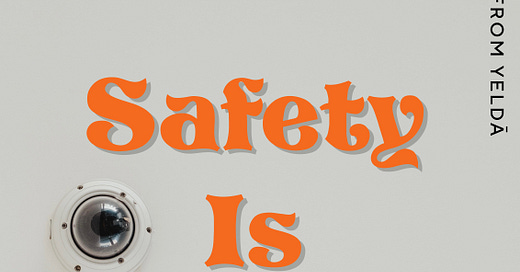Safety is Holistic
Believe your body, pedestalize your intuition, and don't outsource your safety.
When we think about safety, we are often considering external experiences that happen to us. We think about sexual harassment, rape, catcalling, violence, and domestic abuse. But safety is an interconnected part of our well-being that goes far beyond the physical realm. And when we focus so much on the external things that can happen to us, we neglect the internal safety signals that our mind, our gut, and our body provide us. Safety is about more than physical protection.
I’ve spent many years dedicated to women’s safety advocacy, and I’ve learned an endless amount about safety directly from girls and women. One thing I’ve learned is that, when it comes to safety, people are very interested in strengthening their internal tools. Beyond knowing their legal rights or understanding data security, people opt in to learn how to make their bodies feel like home or how to stop self-abandoning. Seeing safety as holistic, as interconnected, allows us to encompass our minds, our souls, and our environments as guides. It allows us to take a more comprehensive approach and recognizes that safety isn’t limited to physical well-being alone.
Believe Your Body.
The body doesn’t lie. Our physical sensations and reactions provide us with valuable information and insight. How many of us have been in a particular situation or midst decision-making, when suddenly our palms start sweating, our muscles get tense, or our heart starts racing? These are somatic markers. Our bodies generate physical responses, and an incredibly important step of safety is paying attention to these sensations.
Here are 3 ways to listen to our body and integrate the signals into our decision-making:
Emotional Cues: Emotions can be associated with bodily changes. Joy and sadness feel entirely different in our bodies. Tune into these responses.
Nonverbal Communication: Facial expressions and body language can convey intentions and even underlying truths that are difficult to express verbally. Pay attention to these cues.
Energy: Even if it’s subtle, we can almost immediately sense positive or negative energy when we walk into a room. Do you feel comfortable or do you feel uneasy? Honor these vibrations.
The mind and body are interconnected, and recognizing these connections help us address emotional or psychological issues that affect our well-being. While being hyper-vigilant of energy may be a trauma response, being vigilant of energy is a way to keep ourselves safe. So trust your body–it provides all the evidence you need.
Pedestalize Your Intuition.
“Trust your gut” is rooted in understanding that our digestive system is our second brain. Without logical explanation, gut feelings and instincts arise as a sense of knowing. Though we’ve been raised to not value this knowing as much as we do logic, our digestive system is rich in neurons. Paying attention to sensations from our body offers valuable insights that go beyond conscious analysis. These signals can help us tap into our intuition, gain self-awareness, and make more authentic and aligned decisions. But developing and nurturing intuition requires courage, and it requires releasing fear.
There are various reasons why we have been conditioned to abandon our intuition. Our societies, namely Western societies, emphasize logic and analytical thinking. Intuition is seen as less reliable, and even irrational. Additionally, we are constantly seeking external validation and rely on other people’s opinions more than trusting our own inner voice. When it comes to decision making, neglecting our inner guidance can lead us directly into unsafe situations.
Don’t Outsource Your Safety.
How many of us have been in relationships where we have trusted the other person, more than ourselves, with our well-being? This is an incredibly risky move–and one that can leave us in unsafe situations. By taking an active role in our safety, we significantly reduce vulnerabilities. No one is a better advocate than ourselves.
While seeking support and help from others is essential when needed, taking responsibility for our own safety is equally as important. This doesn’t mean we should isolate ourselves. In fact, cultivating a network of trusted people is necessary. But these reliable individuals should provide an added layer of security and not be our frontline defense.
It’s All Connected.
Physical safety is the first step–we have to protect our bodies from immediate harm. But ensuring physical security isn’t enough on its own. We have to go deeper.
Emotional safety involves fostering open communication, empathy, respect, and trust. It’s about protecting our hearts and minds. It’s about creating spaces where we can be vulnerable and express our thoughts and feelings without judgment or harm. It’s the foundation of healing, and allows us to grow as individuals and as a community.
Mental safety is the next frontier. We have to take care of our minds. This world can be a heavy burden, and it’s easy to get overwhelmed. Mental safety means addressing the stress, the anxiety, and the burnout. It’s about seeking help, finding balance, and practicing self-care. We have to nurture our minds, they’re precious.
Social safety is about building communities that uplift us. It’s about creating spaces where everyone feels accepted, respected, and valued. It’s about inclusivity, diversity, and equity. It involves combating discrimination and harassment. Social safety means standing together, fostering positive relationships, and fighting for justice.
And let’s not forget about the environment. From reducing pollution to managing resources wisely, environmental safety is about protecting the planet. It’s about pollution control, waste management, and sustainable urban planning. It’s our home, and we must treat it with reverence.
Moving forward, let’s strive for holistic safety and recognize that it’s a fight that encompasses every dimension of our lives. It’s a fight for our bodies, our minds, our souls, and our planet. By embracing holistic safety, we honor our interconnectedness, and we pave the way for a brighter future for ourselves and generations to come.



